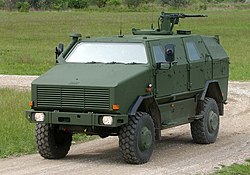V-hull: Difference between revisions
IraqVet225 (talk | contribs) No edit summary |
No edit summary |
||
| Line 1: | Line 1: | ||
[[Image:Otokar cobra.jpg|right|thumb|An [[Otokar Cobra]] with a "V" shaped hull]] |
[[Image:Otokar cobra.jpg|right|thumb|An [[Otokar Cobra]] with a "V" shaped hull]] |
||
[[Image:Dingo_2.jpg|thumb|250px|The [[ATF Dingo]] of the [[German Army]] is a heavily armored infantry mobility vehicle with V-hull design]] |
|||
[[Image:Cougar_Hit_By_IED.jpg|thumb|[[Cougar (vehicle)|Force Protection's Cougar]] with a V-shaped hull hit by [[Improvised explosive device|IED]] in Iraq, all crew survived]] |
[[Image:Cougar_Hit_By_IED.jpg|thumb|[[Cougar (vehicle)|Force Protection's Cougar]] with a V-shaped hull hit by [[Improvised explosive device|IED]] in Iraq, all crew survived]] |
||
The '''V-hull''' is a type of [[vehicle armor]] design used on wheeled [[armored personnel carrier]]s (APC) and [[infantry fighting vehicle]]s (IFV). The design originated in the [[1970s]] with [[South Africa]]n [[Land Systems OMC]]'s designs, the [[Ratel IFV]] and the [[Buffel]].<ref>http://www.machinedesign.com/ASP/strArticleID/59438/strSite/MDSite/viewSelectedArticle.asp</ref> |
The '''V-hull''' is a type of [[vehicle armor]] design used on wheeled [[armored personnel carrier]]s (APC), [[infantry mobility vehicle]]s and [[infantry fighting vehicle]]s (IFV). The design originated in the [[1970s]] with [[South Africa]]n [[Land Systems OMC]]'s designs, the [[Ratel IFV]] and the [[Buffel]].<ref>http://www.machinedesign.com/ASP/strArticleID/59438/strSite/MDSite/viewSelectedArticle.asp</ref> |
||
==Design== |
==Design== |
||
Revision as of 16:01, 28 June 2008


The V-hull is a type of vehicle armor design used on wheeled armored personnel carriers (APC), infantry mobility vehicles and infantry fighting vehicles (IFV). The design originated in the 1970s with South African Land Systems OMC's designs, the Ratel IFV and the Buffel.[1]
Design
The purpose of design is to increase vehicle and crew survivability by deflecting an upward directed blast from a landmine (or Improvised Explosive Device) away from the vehicle, while also presenting a sloped armor face.[2] [3] By presenting its armor at an angle, it increases the amount of material a ballistic projectile must pass through in order to penetrate the vehicle, and increases the chance of deflection.
V-hulls are incorporated in armored vehicle designs in several different ways. Many vehicles, such as the BAE Systems RG-33 incorporate the v-hull into a monocoque chassis, while others, such as the ATF Dingo and International MaxxPro use a body-on-frame chassis, with an armored V-hull crew compartment, and an additional V or semicircular shaped piece protecting the driveline. [4] Others, such as the Cougar H have a V-hull crew compartment, and allow the driveline and suspension components to be sacrificed in an attack, while maintaining the safety of the crew.
